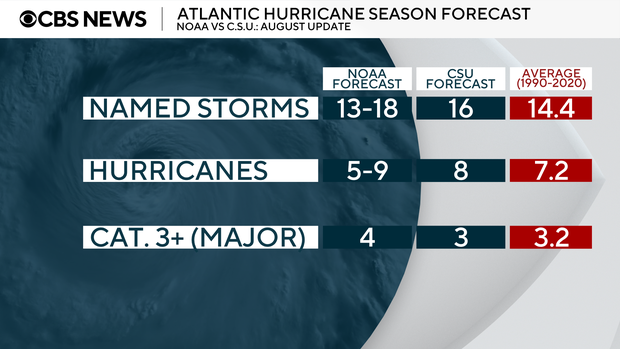Two months into the 2025 Atlantic hurricane season, officials at the National Oceanic and Atmospheric Administration have updated their forecast, predicting slightly fewer named storms. The new outlook released Thursday says there is a 50% chance of above-normal activity, a decrease from 60% in the agency’s May forecast.
NOAA, the federal agency in charge of weather and climate predictions, now expects 13 to 18 named storms, five to nine of which could become hurricanes, including two to five major hurricanes. The previous ranges were 13 to 19 named storms, six to 10 hurricanes and three to five major hurricanes.
The adjusted predictions include the four named tropical storms so far this season.
CBS News
The Atlantic hurricane season officially runs from June 1 until Nov. 30, with peak activity typically occurring between mid-August and mid-October.
An average season produces 14 named storms, including seven that develop into hurricanes. Three of those, on average, become major hurricanes, meaning a Category 3 or higher on the Saffir-Simpson scale, with sustained wind speeds of at least 111 miles per hour. Category 5, the top of the scale, brings wind speeds of at least 157 mph.
Every Atlantic hurricane season since 2015 has produced more storms than the “average” — a standard based on annual hurricane activity recorded over the period from 1990 to 2020 — although four seasons since then have produced two or three major hurricanes, either below or on par with the 30-year norm.
According to forecasters, a combination of factors influence the number of storms that materialize over the course of the season. A significant one in 2025 is the neutral phase of the El Niño-Southern Oscillation, or ENSO, cycle, which often plays a substantial role in the intensity of tropical activity in the Atlantic.
Warmer than average ocean temperatures and weak wind shear in the forecast may also lead to a more active season, the NOAA outlook says, as could the potential for higher storm activity from the West African Monsoon, the weather system from which most Atlantic hurricanes originate.
Some seasons are more active than others, and hurricanes at times can occur outside of the designated six-month window. Science has shown in recent years that climate change is contributing to the intensity of these storms, which are fueled by warmer waters. Researchers are continuing to explore connections between rising temperatures and more destructive tropical weather.
Because each year is different, NOAA’s hurricane forecast provides a framework for communities in storm-prone areas to prepare.
“NOAA stands ready to provide the forecasts and warnings that are vital for safeguarding lives, property, and communities,” acting NOAA Administrator Laura Grimm said in a statement Thursday. “As we enter the second half of the season, this updated hurricane outlook serves as a call to action to prepare now, in advance, rather than delay until a warning is issued.”
Last year, NOAA predicted an above-average number of storms, with between 8 and 13 hurricanes. The 2024 season ended up producing 11 hurricanes, five of which strengthened into major hurricanes. Five hurricanes made landfall in the continental U.S., including two — Helene and Milton — that hit as major hurricanes.
Grimm said last year’s forecast “was right on the money,” within NOAA’s predicted range.
Threat of an above-average hurricane season
Researchers from Colorado State University’s Tropical Cyclones, Radar, Atmospheric Modeling and Software team also predicted an above-average hurricane season for 2025, likely producing stronger and more frequent storms than a typical year but fewer than last season.
They also recently updated their predictions, now estimating that eight hurricanes will occur over the course of the 2025 season with 16 named storms overall.
Their predictions have tended to more or less align with those released by NOAA. Levi Silvers, who leads the research team at Colorado State, told CBS News in April that their predictions are “fundamentally dependent on the observations that NOAA collects all around the globe,” especially in the oceans, so they generally reach similar conclusions.
CBS News
